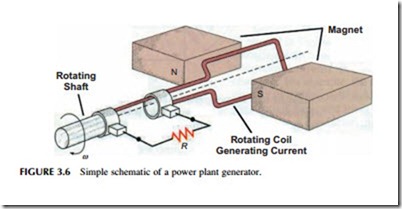GENERATORS
The turbine shaft, or shafts if there are more than one, are coupled to a generator that converts the rotary mechanical motion into the electrical energy that the plant is designed to produce. Generators, like steam turbines, first appeared during the 19th century. All utilize a coil of a conducting material, usually copper, moving in a magnetic field to generate electricity, as shown in Figure 3.6.
The generators used in most power stations, including coal-fired power stations, are designed to deliver an alternating current (AC) to a power grid. An AC current is preferred because it allows the voltage to be raised or lowered easily using a transformer. For transmission of power over long distances it is prefer- able to use a very high voltage and a low current. The voltage is then reduced with a transformer before delivery to the consumer.
The need to generate an AC voltage determines the speed at which the generator rotates. This must be an exact multiple of the grid frequency (normally grids operate at either 50 Hz or 60 Hz). For grids operating at 50 Hz the traditional generator speed is 50 cycles per second, or 3000 rpm for a standard two- pole generator, or half this speed, 1500 rpm, for a four-pole generator. The equivalent 60 Hz two-pole machine rotates at 3600 rpm and a four-pole machine at 1800 rpm. This speed, in turn, determines the operating speed of the steam turbine. Large LP steam turbines may operate at the lower speeds to reduce stress on the long turbine blades.
Generators may be as large as 2000 MW, and large generators are normally designed for the specific project in which they will operate. Modern generators operate with an efficiency of greater than 95%. The remaining 5% of the mechanical input energy from the turbine is usually lost as heat within the gen- erator windings and magnetic components. Even though the percentage is small, this still represents an enormous amount of energy, perhaps 50 MW in a 1000 MW machine. Therefore, generators require very efficient cooling sys- tems to prevent them from overheating. For smaller generators up to around 300 MW, air cooling will normally be sufficient. Larger generators, up to 500 MW, usually use hydrogen cooling. Above this size, the rotating section of the generator, the rotor, will normally be hydrogen cooled while the stationary part, the stator, will be water cooled through pipes embedded into its structure.
The broad outline of generator design has changed little over a century. However, new materials have improved efficiencies. The latest developments involve the use of superconducting materials to reduce energy loss and increase efficiencies. These have yet to achieve commercial viability.
